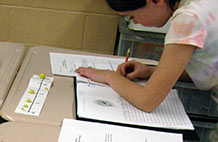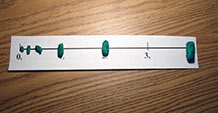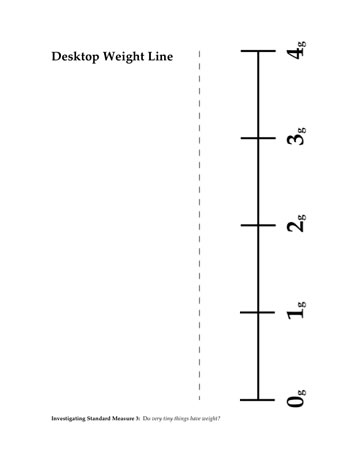Do very tiny things have weight?
Plan Investigating Standard Measures 3
Snowflakes … spider silk … poppy seeds … dust. We can see that very small things occupy space, but do they also have weight?
Formative Assessment
Do students think that very tiny things have weight?
Available online at inquiryproject.terc.edu
In this investigation, students consider the weight of objects that have no perceptible weight and are too small to move the pan balance. They make the tiny objects themselves, taking an 8–gram piece of plastic modeling clay and repeatedly cutting it in halves. After each cut, they place one half on a weight line and then cut the remainder until they have a piece too small for their hands to divide further.
By then end of the investigation, students will identify some weights between zero and 1 gram and will wrestle with the idea that even teeny, tiny things have weight.
Learning Goals
- to consider whether very tiny things have weight
- to understand that there is a place on the weight line for very tiny thingss
| Sequence of experiences | ||
|---|---|---|
| 1. Ask the question | All Class | 10 Mins |
| 2. Place small objects on a weight line | Small Groups | 20 Mins |
| 3. Discuss the weight of tiny things | All Class | 5 Mins |
| 4. Make meaning | Discussion | 10 Mins |
Materials and Preparation
For the class:- Post the investigation question in a place where all students can see it.
- Draw an oversized 4-gram weight line on a flip chart or whiteboard.
- 1 8-gram piece of plastic modeling clay, rolled to the thickness of a pencil
- 2 pan balances
- 1 5–gram weight
- 4 1–gram weights
- 4 plastic knives
- 4 small plates
- 1 desktop weight line labeled from 0 to 4 grams (from notebook)
- 4 approximately 10 grams of plastic modeling clay
Concept Cartoon

The Standard Measures Concept Cartoon is typically used as a formative assessment at the end of this investigation.
Do students think that very tiny things have weight?
Observe students as they work and listen as they make meaning to find evidence of their ideas about whether pieces of matter too small to feel, do actually weigh something.
As you interpret students' comments, listen for these ideas that commonly arise:
- If you can't feel it, it doesn't have weight.
- If you can see it must have weight.
- A tiny creature (a flea) might find this minute piece of clay weighs something.
- If you gather the tiny pieces together, you get a ball of plastic modeling clay that will weigh 8 grams.
The teacher recognized the student was in the process of developing the idea that tiny things have weight. Her next step was a question, "I heard you say that you don't think tiny things have weight but if you squeeze all the little pieces of plastic modeling clay together, you'll have a piece that weighs a gram. If the tiny pieces don't have weight, where do you think that weight comes from?"
1. Ask the question
Begin by asking students to name some of the very smallest things they can think of. Once you have a list, ask students how much they think these things weigh — or whether they have any weight at all.
Introduce the investigation question:
- What if you can't feel any weight in your hand?
- What if you can't measure any weight in the pan balance?
- What if the object is lighter than 1 gram? Is there still weight?
Ask students what they think about the weight of something tiny, such as an eraser rubbing. After erasing something, do they think the tiny pieces of rubber that are left on the paper have weight? You may want to modify the posted investigation question to read, “Do eraser rubbings and other very tiny things have weight?
Detours: Some students may object to using the new weight lines. They may think that the new scale will somehow misrepresent the weights. Explain that unlike a meter stick or ruler, a weight line is not used to make measurements; it is used to display them. The spaces between gram markers can be any size as long as they are all the same size.
Have students exchange their ideas, but leave the questions unanswered. Let them know they will work with some tiny objects today. Show students the desktop weight lines they will use.
- How is this weight line different from the one we used last time, when we displayed the weights of the cubes?
- The whole numbers are much farther apart, and the upper limit is 4 grams.
- Do you think we can use this weight line to display very tiny things? Why or why not?
Show students the 8–gram piece of plastic modeling clay. Demonstrate how they might roll the plastic modeling clay, cut it in half, and place one half on the weight line in its proper place. Drawing attention to the oversized weight line you have drawn on the board, ask students, “Where will that first piece go? If you cut the remaining piece in half, where will the next piece go?”

When you have a consensus, draw circles at 4 grams and 2 grams on the class weight line. Before the class breaks into small groups, have students predict how many times they will be able to cut the plastic modeling clay in half.
- Will you run out of plastic modeling clay? Will you run out of weight?
2. Place small objects on a weight line
Measure and explore
This is the heart of the investigation, where students consider the weight of ever–smaller pieces of plastic modeling clay. As the weights fall below 1 gram, students wrestle with the idea of fractional weights that approach zero on the weight line. As they cut smaller and smaller pieces, and can no longer feel the weight in their hands, they confront the question: Does weight disappear?

Students first weigh their undivided portions of plastic modeling clay in the pan balance, then work on their own to cut the material in halves, using a plastic knife. When groups have three pieces placed on their weight line. Check that the pieces are placed at the 4–gram, 2–gram, and 1–gram markers.
- How much does the remaining piece weigh?
- 1 gram
- Can you feel that weight in your hand?
- Yes, it feels the same as the red 1-gram weight or a large paper clip.
Note: Working with plastic modeling clay. Plastic modeling clay is a good material for this exercise because it can be manipulated between cuts. If the first piece is rolled to pencil thickness, it will be easy to estimate the middle and cut it into two 4-gram pieces. You might point out that cut pieces will be easier to halve if they are first rolled into a longer, thinner pieces; or help students to discover this on their own. By working with thinner and thinner rolls, students should be able to halve the original 8 grams at least six times, possibly more.
When students cut the 1-gram piece in half, and place one piece on the weight line, check to see where it is placed.
- How much does the remaining piece weigh?
- Half a gram
- Can you feel that weight in your hand?
- If I cut a 1/2-gram piece of plastic modeling clay into two equal parts, is there a place on the weight line to put one of the pieces? Does it still weigh something?
Continue this process one step at a time. Naming or writing the fractions below ¼ is not important to this work, but see if students develop a sense of where to place the quarter–gram, the eighth–gram, and subsequent pieces on the weight line. Do they see the pattern? They are moving half the distance toward zero each time.
Is the weight really disappearing? When students claim they can no longer feel the weight, suggest that they drop the piece 6 inches from one hand to the other. They should feel the piece of plastic modeling clay hit the hand. Do they agree that if they can feel something hit, it must have weight? When they can no longer feel a piece landing in a palm, ask them to drop the piece onto the back of the hand, which is more sensitive than the palm.
- Do you think objects have weight, even if we can't feel the weight?
Have students sketch their weight line with the pieces of plastic modeling clay placed on it in their notebooks. Students should also record their thoughts on the weight of the plastic modeling clay pieces.
3. Discuss the weight of tiny things
Thought experiment

Once it becomes impractical for students to further divide the pieces of plastic modeling clay, move the exploration to a thought experiment.
- If we had tiny hands and tiny knives, how many more times do you think we could cut the bits of plastic modeling clay in half?
Have students imagine cutting their smallest piece on the weight line in half again. Have them make a mark with a pencil showing where it would go on the weight line. How many times do they think they could cut the plastic modeling clay and place the pieces on the weight line?
- What if the weight line were really huge, like the length of our classroom? How many pieces of plastic modeling clay could you fit between zero and 1 gram?
- What if the weight line were as long as the street in front of the school? Or as long as from here to China?
- Do you think there is there a place on the weight line for every teeny, tiny piece of material?
4. Make meaning
Purpose of the discussion
This discussion will bring forward the idea that a piece of a material can be so small you can't "feel" any weight - and it may not even register weight on a balance scale - but it still has a place on the weight line. It has weight. You can probe what students mean when they say something "doesn't weigh anything:" do they mean they can't feel or sense any weight or that it weighs nothing and, therefore, shouldn't have a place on the weight line? This discussion can also bring forward evidence from this class that tiny things have weight: if you collect lots of tiny pieces, at some point when there are enough of them, you can "feel" their weight - this suggests that each tiny piece must contribute to the weight of the collection.
Revisit the list of properties used to sort
Return to the idea that (if you can imagine having the right tools) you could keeping cutting pieces of plastic modeling clay in half over and over again and putting these smaller and smaller pieces on the weight line.
Engage students in the focus question
Do tiny things have weight?
There's a difference between an object being so small you can't feel any weight and actually weighing nothing.
- We found that even teeny, tiny pieces have a place on the weight line (evidence from their investigation) so tiny things have weight (reasoning).
- If it's matter, even just a tiny bit, it has to have weight (reasoning).
If you gather up enough tiny pieces and add them together, the collection will weigh something, therefore, each piece weighs something.
- We started with 8 grams of plastic modeling clay, divided the pieces in half over and over again into lots of tiny pieces that didn't feel as if they had weight. If we collected all the pieces and smooshed them into a ball, the ball would weigh 8 grams.
We decided there is a place on the weight line for any piece of plastic modeling clay even if it's very, very small.
- The smaller the piece, the closer to zero on the weight line. You can't have something on zero (nothing) or on the other side of zero (you can't have negative matter).
Supporting questions
- If you keep cutting the plastic modeling clay pieces in half, will you ever get to zero on the weight line?
- No, you can't have zero material, although the pieces get closer to zero on the weight line the smaller they get.
- Can an object have weight if we can't feel it in our hands?

- Ask students to imagine using a pencil eraser so much that the whole eraser becomes a pile of tiny eraser rubbings. If you saved every tiny piece of rubbing and piled them together, would they have the same weight as the original eraser? If each tiny rubbing had zero weight, how could there be any weight when you pile them all together? Where would that weight come from? Isn’t the eraser like a collection of eraser rubbings all melted together?
- If a ball of string has weight, does 1 inch of string have weight? Does half an inch? How about a quarter–inch? Do all the pieces added together have the same weight as the original ball of string? If students had cut up the whole 8 grams of plastic modeling clay into teeny, tiny pieces, would all the tiny pieces together weigh 8 grams? If not, what happened to the weight?
Recap the discussion
Summarize the idea that our hands (and even balance scales) are not all that good at sensing small amounts of weight or small differences in weight. Students have experienced this when they used felt weight to order the cubes. Now we are gathering evidence that objects or small bits of material can have weight even if we can't feel it. Sensing weight is limited by our hands or instruments, not by the size of the particle.










